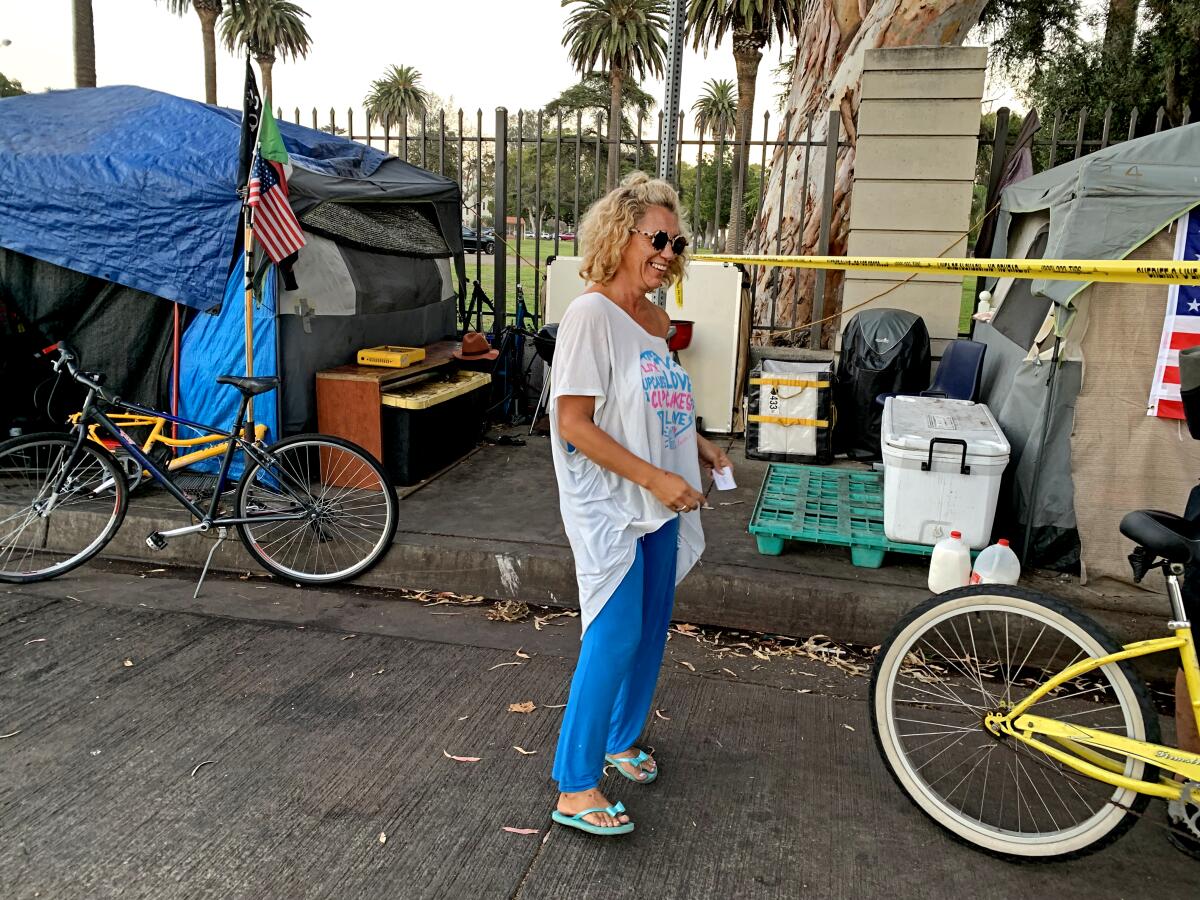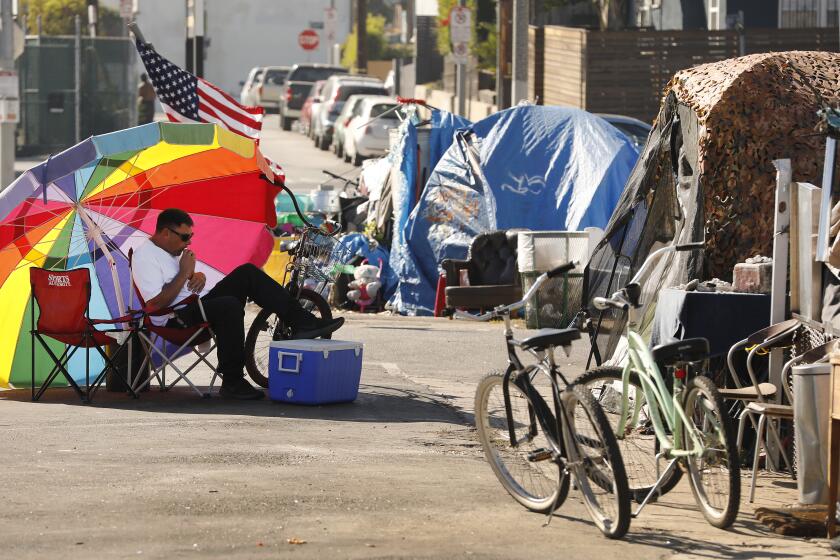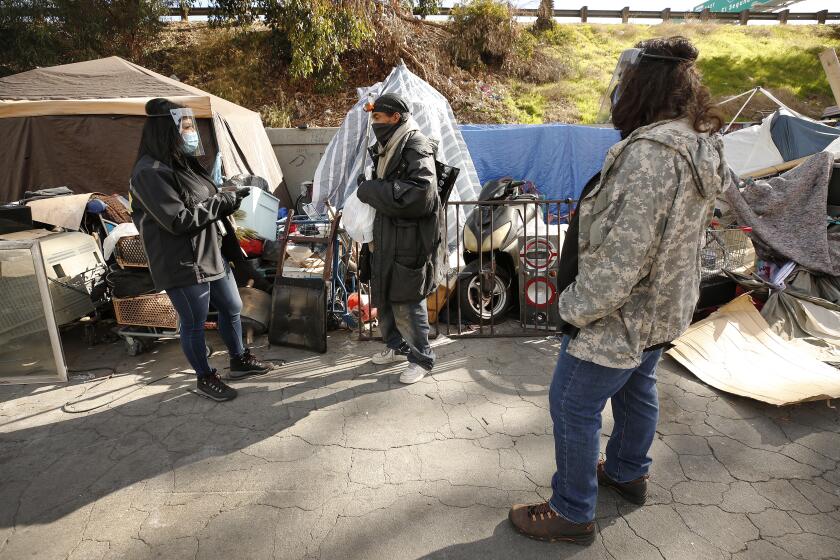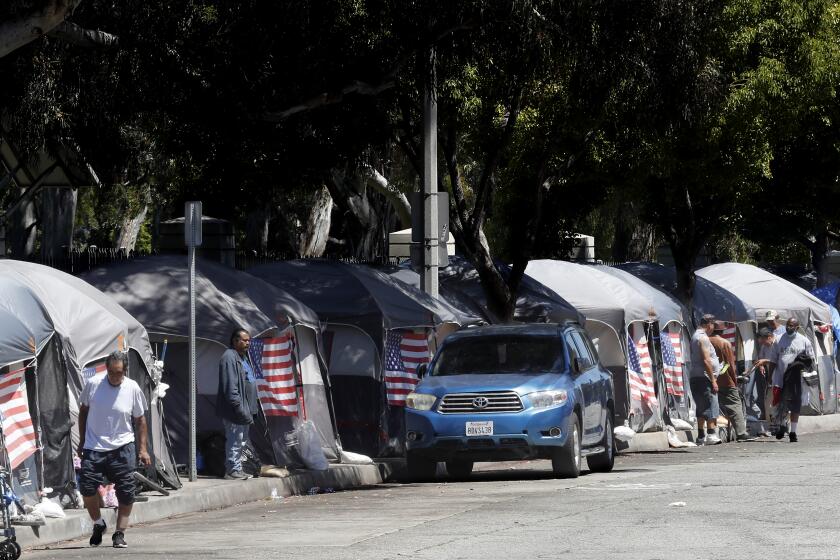Editorial: We need to house residents of homeless encampments even when there isnât a crisis

All homeless people need housing, whether they live in an encampment or unfurl a sleeping bag in a doorway at night. The issue has always been one of priorities â whom do you help first? Do you seek out the most vulnerable homeless people suffering from physical or mental illness? Do you dismantle an encampment inhabited by dozens or hundreds, some of whom have disabilities and illnesses and others who suffer only from poverty?
Or do you house â or shelter â all of the estimated 4,600 homeless individuals who live on skid row in downtown Los Angeles, the epicenter of homelessness in the city? Thatâs what U.S. District Judge David O. Carter ordered the city of Los Angeles to do in a six-month time period as part of a preliminary injunction requested by the L.A. Alliance for Human Rights â a group of downtown property owners, residents and others suing the city and county over grim conditions in the skid row area.
On Thursday, a panel of the U.S. 9th Circuit Court of Appeals unanimously struck down that sweeping order saying that Carter had overstepped by granting an injunction based on claims not made in the original complaint.
The city is better off without the order. Of course, Carter was spot-on in his connection of racism and homelessness in the original order. But he was wrong to compel the city to prioritize housing all of the homeless people living on skid row in a matter of months. To comply quickly, the city would have spent tens of millions on temporary shelters rather than the permanent housing that homeless people desperately need.
Residents may be frustrated seeing encampments in their neighborhoods, but having police shoo people away wonât solve homelessness.
Some nonprofit service providers, elected officials and city and county officials who work on homelessness issues believe housing an entire encampment may be the best way forward in a county with about 66,000 homeless people. Over the last year, the interest in encampment-to-housing, as the approach is often called, has grown as the city undertook two high-profile, fairly successful efforts to move nearly 200 people out of Echo Park Lake into temporary housing and an additional 211 living along Ocean Front Walk at Venice Beach into mostly temporary housing. There have been a few other smaller, quieter encampment-to-home moves also.
And they may be right. It makes sense to prioritize housing the residents of an encampment in a public park or at a beach. No one should be camping in a park â amenities such as these should be shared by all.
Of course, the optics of housing an entire encampment are another reason city and county officials prefer this approach. Itâs a visible statement that theyâve done something about homelessness. That should not be the primary motivation for action, however. Choosing an encampment to house should be done for smart reasons, not to score political points or appease an angry neighborhood that complains the loudest about a nearby encampment.
But where does the long-standing encampment on San Vicente Boulevard near the Brentwood neighborhood fit in? It has been getting a huge amount of attention since a camp resident was fatally stabbed last week when he supposedly intervened in a domestic dispute involving his alleged assailant â another man living in the camp who has been arrested.
The camp is a sprawling chain of nearly identical sturdy tents on a county-owned sidewalk that never had a lot of pedestrian traffic. It is flanked on one side by the city of L.A. and the other side by the iron fencing of the Department of Veterans Affairs West L.A. campus. Of the estimated 50 people living in the camp, about 40 to 45 are veterans, according to VA officials. Most of them are eligible for the safe camping and amenities the VA offers on its grounds but for varying reasons are not interested in living on the grounds.
Los Angelesâ anti-camping ordinance is now in effect. But it should not be enforced until the street strategy for offering housing to homeless people is in place.
Shalise Garcia, who goes by the name Coco and lives in the camp with her boyfriend, a Marine veteran, told a Los Angeles Times editorial writer last week that violent disagreements in her encampment arenât much different from violent disagreements in communities of homes. âHow weâre living here is the same as out there,â she said. âJust they have bigger walls and doors. You canât control whatâs going to happen out there.â
But that homicide was the second one in the camp since April, when a homeless man was run over by a car driven by another homeless man. Earlier this year, a car plowed into the encampment, injuring three people. And according to county homeless services officials, there is a serious rat infestation in the camp. All this makes rehousing the people in the camp an urgent public health and safety issue.
The advantage of working on one encampment is that service providers can focus their outreach workers in one place over one extensive time period and spend more concentrated time with more people. Also, people scared to leave what they know in a camp can be persuaded to go when they see their neighbors taking housing. In some cases, groups of people from an encampment can move together.
Outreach has taken place regularly at the West L.A. camp over the years. But it obviously hasnât been as successful as it should have been. According to L.A. Homeless Services Authority officials, there are veterans sitting in that encampment with housing rental vouchers in hand who have not been able to find housing. Yet, say officials, there are more than 200 available units of supportive housing in developments around the county set aside for veterans.
Moving the occupants of an encampment together is sometimes a good idea but the priority should be the most desperate homeless people.
In general, it can be difficult to find landlords willing to rent to homeless people, and sometimes the individuals themselves turn down available housing. But given the fact that so many units dedicated to veterans are sitting empty, officials should undertake an intensive effort to house this entire encampment â as L.A. County Supervisor Sheila Kuehl has pledged that the county and service providers will do. By the end of the year â Kuehlâs time frame â no one should be sitting at that camp with a housing voucher and no place to use it. As Garcia said, âThe sooner we get into housing the better.â
If officials are going to concentrate on moving whole camps of homeless residents into housing, the West L.A. encampment is a good place for this kind of laser focus. It just shouldnât have taken a killing to make that happen.
More to Read
A cure for the common opinion
Get thought-provoking perspectives with our weekly newsletter.
You may occasionally receive promotional content from the Los Angeles Times.













